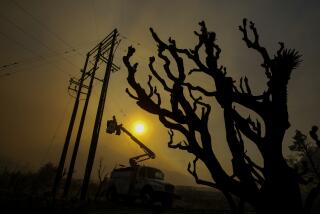USC Study Supports Findings of Electromagnetic Link to Leukemia
- Share via
Los Angeles County children who live near high-current power lines and who are exposed frequently to certain appliances such as hair dryers and electric blankets may be at a small increased risk of leukemia, according to a preliminary USC study released Thursday.
The study, presented at a scientific conference in Carmel, supports findings of previous research and is likely to heighten concern about possible links between cancer and weak electric and magnetic (EM) fields. Funded by the electric power industry, the research is considered the most scientifically rigorous investigation of its kind to date. But as with past studies, the data contains ambiguities that underscore gaps in understanding the effects of EM fields.
Electric and magnetic fields are invisible lines of force that radiate outward from every wire and device that carries electric current, dropping off sharply with distance from the source.
Launched in 1986 by USC researchers, the study found that risk of childhood leukemia varied with proximity to and size of transmission and distribution lines. Children who lived nearest to high-current lines--and were considered to have higher exposures--got leukemia at 2.5 times the average rate.
Leukemia each year on average strikes about 1 of every 25,000 children under age 15, according to state health department data.
However, the study found only a weak connection between leukemia rates and actual EM field measurements taken inside homes. In a written summary, the researchers said it was unclear why inferred exposure from power lines “correlates with leukemia risk better than measured exposure.” They also said high, short-term exposures from appliances may create higher risks, but said that issue required more research.
Led by Dr. John Peters, a USC professor, the team presented its findings at a closed meeting of dozens of scientists involved in EM fields research. Peters and his colleagues declined interview requests, but summaries were provided by them and the Electric Power Research Institute, a Palo Alto-based utility industry group that underwrote the project. A final report is to be completed within four months and submitted to a scientific journal.
The study compared 232 children age 10 and under who contracted leukemia from 1980 to 1987, with 232 healthy children. The children were matched according to age, sex and race, and compared on the basis of residential history, exposures to electric appliances, and parental occupation, smoking and drug-use histories.
Much of the information was based on interviews with parents. Investigators also took 24- to 72-hour field measurements inside all of the homes, including in each child’s bedroom.
Since 1979, a majority of studies have found small increased risks of cancer, including leukemia and brain cancer, among children living near high-current lines. Other studies have shown increases in certain types of cancer among workers in electrical occupations, such as utility linemen and motion picture projectionists.
However, most of those studies lacked detailed interviews with subjects or measurements of actual exposures. The USC study included both.
Dr. David O. Carpenter, dean of the School of Public Health at the State University of New York in Albany and former head of a major research project on EM fields, predicted that the study will “raise general national concern about the role of electric and magnetic fields in causing cancer.”
The study “should put an end to the argument that the previous results were spurious,” said Louis Slesin, editor of Microwave News, a New York-based newsletter that has monitored the controversy.
Some studies have suggested that certain appliances, such as electric blankets and video display terminals, create hazards by exposing users to elevated fields for hours at a time. The USC researchers said their information provides considerable support for a link between children’s frequent appliance use and leukemia risk.
But they acknowledged the pitfall of “recall bias”--the probability that parents of sick children are more likely to remember and report past exposures.
Like some prior studies, this one also found independent associations between leukemia and other environmental factors. For example, pesticide use in the home was associated with leukemia risks 2.5 times above average--about the same as for children living nearest to high-current lines.






